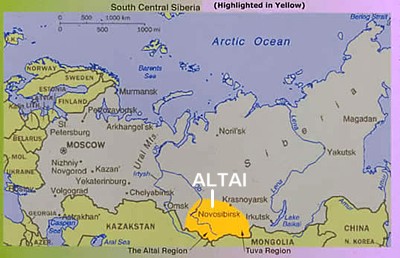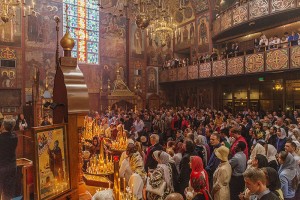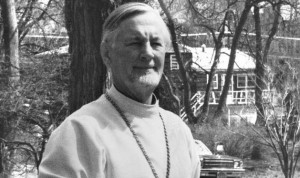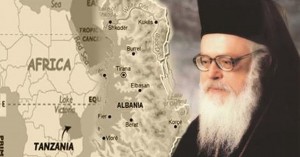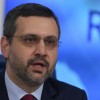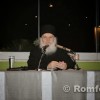Today the Russian Orthodox Church celebrates the memory of St. Macarius of Altai, about whom relatively little has been written in English. To help remedy this lack, we offer a brief biography of the saint, a short history of the Altai Ecclesiastical Mission, and a summary of the missionary principles it employed.
Biography of St. Macarius of Altai
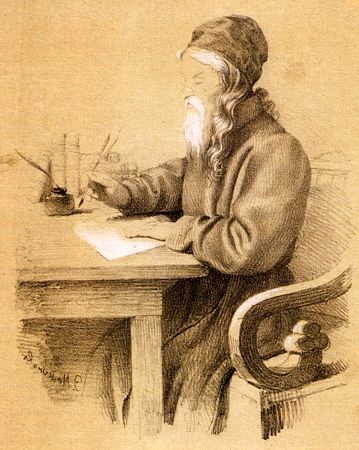 Michael Glukharev was born on November 8, 1792, into the family of a priest who served in the Cathedral of the Entry of the Most Holy Theotokos into the Temple in the city of Vyazma (Smolensk province). The saint studied in the Vyazma ecclesiastical school, the Smolesnk seminary, and then in the St. Petersburg Theological Academy, where he became a faithful disciple of St. Philaret (Drozdov), who was then Rector of the Academy.
Michael Glukharev was born on November 8, 1792, into the family of a priest who served in the Cathedral of the Entry of the Most Holy Theotokos into the Temple in the city of Vyazma (Smolensk province). The saint studied in the Vyazma ecclesiastical school, the Smolesnk seminary, and then in the St. Petersburg Theological Academy, where he became a faithful disciple of St. Philaret (Drozdov), who was then Rector of the Academy.
At age twenty-seven, Michael was tonsured into monasticism, receiving the name of Macarius. In 1821, Fr. Macarius was elevated to the rank of Igumen and later Archimandrite and appointed to administer the Kostroma-Theophany Monastery. At the end of 1825, he was released to the Kiev-Caves Lavra for reasons of health. In 1826, Archimandrite Macarius was transferred to the Glink-Theotokos Hermitage in the Diocese of Kursk to place himself under the spiritual guidance of Igumen Philaret (Danilovsky), Superior of the Hermitage. Fr. Macarius – who had brilliantly completed the Kiev Theological Academy, knew many languages, had been Rector of the Kostroma Theological Seminary and Superior of the Theophany Monastery; who was a Professor of Theology and Archimandrite – transferred to the poor Glinsk Hermitage to be under the guidance of the unlearned but spiritually experienced Fr. Philaret. The learned Archimandrite had always been under spiritual direction: first under his pious father, who was a priest; then at the St. Petersburg Theological Academy under its Rector, Archimandrite Philaret (Drozdov); and then in Yekaterinoslav, as the Inspector of the theological seminary, under the direction of the Elder Laurence, “a man of holy life and a disciple of the famous Paisius Velichkovsky.”
Alongside his monastic labors in the Glinsk Hermitage, Fr. Macarius translated Holy Scripture and the Holy Fathers.
With the blessing of Metropolitan Philaret of Moscow, Archimandrite Macarius petitioned the Holy Synod for permission to work as a missionary in the Altai region to bring the Turkic peoples living there to Orthodoxy.
Fr. Macarius went to the Altai region with his assistants, the seminarians Alexei Volkov and Vasily Popov. By common agreement, they founded a brotherhood, one of the rule of which read: “We desire that all things be held in common: money, food, apparel, books, and other objects: this measure will accommodate us in the pursuit of unanimity.”
At first the indigenous people did not want to have dealings with Fr. Macarius and avoided Christianity. But later they reconsidered and Fr. Macarius became acquainted with the Ulala Teleuts and began to gather members into Christ’s Church from among the Chernov Tartars and Altai Kalmyks, settling them in Maim and other villages. The majority of them, having heard the word of truth from him, received Holy Baptism and became as devoted to him as children are to their father. It is astonishing how Fr. Macarius, who suffered from physical ailments, was able to endure both lengthy crossings across mountain streams and the privations of travel when fulfilling his pastoral duties: catechizing, baptizing, and visiting his spiritual children. During this time he began to think about teaching literacy to the native people. Otherwise they would not be able to grasp the meaning of his preaching or participate in the divine services. Thus began his enormous work of research in creating a written language and dictionary for the Altai language.
The first period of the missionary activity of Fr. Macarius was the most difficult, yet some positive results were nonetheless achieved: the conversion of some, albeit few, pagans to Orthodoxy; the creation of settlements for the newly-baptized natives; and the opening of the first missionary schools. Fr. Macarius understood that the newly-baptized needed his full support in their first years and could not be left to fend for themselves. He constructed houses for the newly-baptized and acquired livestock, farming tools, and seeds for the sowing of crops – in short, everything they needed for a sedentary way of life.
A woman’s community, which was later transformed into a convent, was established at the Ulala encampment.
The venerable one reposed on May 18 (old calendar), 1847, in the Bolkhov Monastery (Diocese of Oryol), where he had been superior since 1844, following his return from the Altai region. The Jubilee Council of the Russian Orthodox Church numbered him among the saints in 2000. His memory is celebrated on May 18/31.
Translated from the Russian
A Brief History of the Altai Ecclesiastical Mission
By Peter Vasilyevich Znamensky
The first properly organized mission in western Siberia was opened in 1828 by initiative of Archbishop Eugene (Kazantsev) of Tobolsk, under the leadership of Archimandrite Macarius (Glukharev), former Rector of the Kostroma Seminary and a man of deep religious faith and selfless devotion to missionary work. Altai was chosen as its place of operation, a country that had not yet been penetrated by Christianity. It was inhabited by Tartars, Kalmyks, and other indigenous people, the majority of whom were pagans. Macarius arrived here in 1830 and operated out of Ulala, although he annually conducted tireless journeys throughout the entire country. He quickly learned the Altai dialect of the Tartar language and created a dictionary and many translations necessary for the enlightenment of the indigenous people (the Lord’s Prayer, the Ten Commandments, a short sacred history, the rite of questions of faith posed at baptism, several psalms, and the Gospel according to St. Matthew).
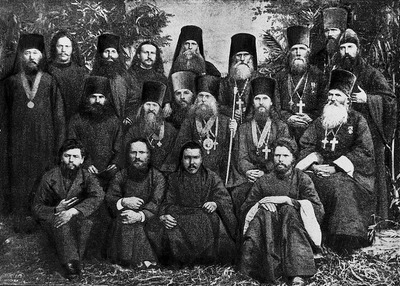
Bishop Vladimir with members of the Altai Ecclesiastical Mission in 1880
A cordial and loving man, he was the teacher, doctor, educator of children, intercessor before the authorities, and general benefactor of his spiritual children. However, the mission’s funding was only 571 rubles, yet he was able to find wealthy donors in Tobolsk and Moscow. He likewise used all his own resources, including his own salary, to assist the new Christians. Over the course of fourteen years, he acquired up to 675 souls for the Church and constructed three missionary camps with two churches and one chapel, since in his missionary efforts he relied on the powerful effect of Orthodox divine services above all else. He opened a school in Ulala, a woman’s philanthropic community, a hospital, and several permanent settlements for the new converts.
In 1844, due to the collapse of his health, he retired to the Bolkhov Monastery, having succeeded in establishing a fine example for other missions. His efforts were successfully continued by his successor and former colleague, Archpriest Stephan Landyshev (from the Nizhny-Novgorod Seminary), and subsequent heads of the mission, especially Archimandrite Vladimir (Petrov) (1866-1883). In 1857, the mission’s funding was increased to 5,500 rubles a year, with a staff of twenty people. Beginning in 1865, divine services in Altai were held in the local language. Owing to its many translations, the mission received its own censor and press in 1874. Each year the number of converts began to grow by hundreds rather than dozens. By 1895, the mission had seventy members, fourteen mills, and upwards of forty-seven churches and prayer houses, two monasteries, a parochial trusteeship, and many charitable organizations. It was able to settle more than 10,000 nomadic people in settled residences around its mills.
In 1880, the Altai region, which since 1832 had been part of the Diocese of Tomsk, was given a vicar bishop of Biysk. Archimandrite Vladimir, head of the mission, became its first vicar bishop. Following in the footsteps of the Altai Ecclesiastical Mission, several new missions opened in the Diocese of Tobolsk (to which it had formerly belonged), although on a smaller scale and with fewer resources: Obdorsk (1884), Surgut (1867), and Turukhansk (1850), which was added to the Diocese of Yeniseysk in 1860 and closed in 1872. In the southern part of the latter diocese, a mission was opened in the Minusinsk district in 1876. In the southern parts of the Diocese of Tomsk – which became part of the Diocese of Turkestan in 1871 – the Semirechye mission opened in 1868, centered around the missionary brotherhood in the city of Verny.
Translated from the Russian
The Missionary Principles of the Altai Ecclesiastical Mission
The following summary of the missionary principles of the Altai Ecclesiastical Mission comes from a talk given by Irina Soldatova at the 16th “Sretensky Readings” Conference in 2008.
1. The principle of the need for serious missionary preparation was primary during the entire existence of the Altai mission. Thanks to this principle, the serious preparation and training of missionaries – including natives – was carried out; missionaries acquired ascetic habits; they became acquainted with the people, their manners, customs, pre-Christian beliefs, and language. In this, prayer was essential and the mission’s material support was also important.
2. In accordance with the mission’s principle of sequentiality, the missionaries first became acquainted with the people among whom they intended to preach the Good News, delving into their everyday problems, and growing accustomed to the people. Then they would provide practical assistance, communicating in a friendly manner with each person. Only thereafter would they begin the diligent preaching of God and faith. The establishment of trusting relationships, the teaching of literacy, fellowship between the newly-baptized and their pagan kin, divine services, extra-liturgical discussions with the singing of verses and the showing of illuminated images, as well as the interior and exterior appearance of the church – all this had an enormous influence on the gradual conversion of the people of Altai to the Christian faith. Unfortunately, due to the lack of missionaries, the vast distances, the absence of roads, and the limits of time, the missionaries were not always able to establish trusting relationships, so essential in missionary work, and therefore in such cases were not able to attain positive results. For these same reasons, baptism sometimes took place without proper preparation, which led to the emergence of dual faith [dvoeveriia: an admixture of Christianity and paganism].
3. The personal examples of the Altai missionaries – their constant manifestation of faith and love – became one of the most effective aspects of their preaching.
4. The employment of knowledge about the mentality, way of life, and religious beliefs of the people among whom they were preaching was an integral part of the mission. Thanks to this knowledge, and its use in their activity, the missionaries were able to find correct, simple solutions to various missionary difficulties, as well as to develop principles and methods of mission that were more suitable for the conversion of the people of Altai to the Christian faith. It also allowed them the opportunity to use this knowledge to combat the false teachings and prophecies that arose in the Altai region in the twentieth century. With the appearance of indigenous missionaries, this principle became an integral part of the mission, which had a positive impact on the conversion of the pagans.
5. Delivering the truth in the people’s native language was one of the most important and effective missionary principles. Moreover, teaching literacy to the Altai people allowed them better to absorb Christian truths, as well as to make it possible for the native peoples themselves to spread Christianity, which became a widespread practice in the Altai mission.
6. Thanks to the missionaries’ recognition of human freedom in choosing one’s faith and their rejection of the coercive methods of baptism practiced in the seventeenth and eighteenth centuries, the people of Altai consciously accepted and were baptized into the Christian faith, as a rule became real Christians. The Altai missionaries consciously avoided seeking “high outcomes.” The most important thing for them was bringing people to faith, not the number of people they baptized.
7. Nonetheless, after nearly ninety years of successful work, the Altai mission came to an end. The reasons for this lay not just in the continuing shortage of missionaries and material means, but also in the fact that any departure from their missionary principles, however seemingly slight, led to negative consequences. For example: ignorance of the language by missionaries; the practice of spreading Orthodoxy through noble titles or the adoption of practices in which practical and worldly interests were the cause of baptism; and intolerance for the ancient religion of the indigenous people and prohibitive measures against shamanistic rites. The mission’s crisis and termination is also connected with the fact that the missionary camps and schools turned into regular parochial institutions, losing everything that was mission-specific.












